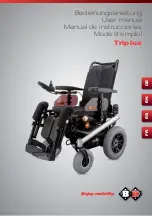
30
DIETZ GmbH / User manual adaptive wheelchair AS[01 | AS[01]RF / Version 3.0.0 EN
04 USING THE WHEELCHAIR
Wheelchair occupant restraint system
The wheelchair restraint system must be secured
first. The wheelchair user is secured according to
ISO 10542 by an appropriate restraint system.
When doing so, the following must always be
ensured:
t
Fasten the shoulder and lap belt. Both of
these belts must be fastened quite
tightly, but not so tight as to cause
discomfort to the wheelchair user and
must not be twisted.
t
The upper part of the safety belt must
run across the torso and shoulder/
collarbone.
t
The lap belt must run at an angle of 30°
to max. 75° from the horizontal but
under no circumstances greater than 75°
(Fig.35).
t
Safety belts must not be routed over
components of the wheelchair, such as
armrests or wheels, which would hold it
away from the body. (Fig. 36).
t
Only products that are certified accord-
ing to ISO 7176-19/ISO 10542 or DIN
75078-2 (tie-downs) and have been
identified accordingly by the manufactur-
er may be used as a restraint system.
t
The wheelchair’s parking brakes must be
fully engaged throughout the drive.
100 mm
55°
30°
75°
100 mm
55°
30°
75°
Correct way to attach the safety belts
Wrong way to attach the safety belts
WARNING
The geometry of the attachment points (or of
the fastening system) must be adjusted with
just as much precision as the wheelchair user’s
safety belts to ensure that a wheelchair user
seated in a wheelchair inside a vehicle will be
safety transported. Non-observance of these re-
quirements can put the wheelchair user’s life at
risk in the event of an accident.
Fig. 35
Fig. 36

![Предварительный просмотр 16 страницы Dietz Rehab AS[01] User Manual](http://thumbs.mh-extra.com/thumbs/dietz-rehab/as-01/as-01_user-manual_2495939-16.webp)
![Предварительный просмотр 17 страницы Dietz Rehab AS[01] User Manual](http://thumbs.mh-extra.com/thumbs/dietz-rehab/as-01/as-01_user-manual_2495939-17.webp)
![Предварительный просмотр 18 страницы Dietz Rehab AS[01] User Manual](http://thumbs.mh-extra.com/thumbs/dietz-rehab/as-01/as-01_user-manual_2495939-18.webp)
![Предварительный просмотр 19 страницы Dietz Rehab AS[01] User Manual](http://thumbs.mh-extra.com/thumbs/dietz-rehab/as-01/as-01_user-manual_2495939-19.webp)
![Предварительный просмотр 20 страницы Dietz Rehab AS[01] User Manual](http://thumbs.mh-extra.com/thumbs/dietz-rehab/as-01/as-01_user-manual_2495939-20.webp)
![Предварительный просмотр 21 страницы Dietz Rehab AS[01] User Manual](http://thumbs.mh-extra.com/thumbs/dietz-rehab/as-01/as-01_user-manual_2495939-21.webp)
![Предварительный просмотр 22 страницы Dietz Rehab AS[01] User Manual](http://thumbs.mh-extra.com/thumbs/dietz-rehab/as-01/as-01_user-manual_2495939-22.webp)
![Предварительный просмотр 23 страницы Dietz Rehab AS[01] User Manual](http://thumbs.mh-extra.com/thumbs/dietz-rehab/as-01/as-01_user-manual_2495939-23.webp)
![Предварительный просмотр 24 страницы Dietz Rehab AS[01] User Manual](http://thumbs.mh-extra.com/thumbs/dietz-rehab/as-01/as-01_user-manual_2495939-24.webp)
![Предварительный просмотр 25 страницы Dietz Rehab AS[01] User Manual](http://thumbs.mh-extra.com/thumbs/dietz-rehab/as-01/as-01_user-manual_2495939-25.webp)
![Предварительный просмотр 26 страницы Dietz Rehab AS[01] User Manual](http://thumbs.mh-extra.com/thumbs/dietz-rehab/as-01/as-01_user-manual_2495939-26.webp)
![Предварительный просмотр 27 страницы Dietz Rehab AS[01] User Manual](http://thumbs.mh-extra.com/thumbs/dietz-rehab/as-01/as-01_user-manual_2495939-27.webp)
![Предварительный просмотр 28 страницы Dietz Rehab AS[01] User Manual](http://thumbs.mh-extra.com/thumbs/dietz-rehab/as-01/as-01_user-manual_2495939-28.webp)
![Предварительный просмотр 29 страницы Dietz Rehab AS[01] User Manual](http://thumbs.mh-extra.com/thumbs/dietz-rehab/as-01/as-01_user-manual_2495939-29.webp)
![Предварительный просмотр 30 страницы Dietz Rehab AS[01] User Manual](http://thumbs.mh-extra.com/thumbs/dietz-rehab/as-01/as-01_user-manual_2495939-30.webp)
![Предварительный просмотр 31 страницы Dietz Rehab AS[01] User Manual](http://thumbs.mh-extra.com/thumbs/dietz-rehab/as-01/as-01_user-manual_2495939-31.webp)
![Предварительный просмотр 32 страницы Dietz Rehab AS[01] User Manual](http://thumbs.mh-extra.com/thumbs/dietz-rehab/as-01/as-01_user-manual_2495939-32.webp)
![Предварительный просмотр 33 страницы Dietz Rehab AS[01] User Manual](http://thumbs.mh-extra.com/thumbs/dietz-rehab/as-01/as-01_user-manual_2495939-33.webp)
![Предварительный просмотр 34 страницы Dietz Rehab AS[01] User Manual](http://thumbs.mh-extra.com/thumbs/dietz-rehab/as-01/as-01_user-manual_2495939-34.webp)
![Предварительный просмотр 35 страницы Dietz Rehab AS[01] User Manual](http://thumbs.mh-extra.com/thumbs/dietz-rehab/as-01/as-01_user-manual_2495939-35.webp)
![Предварительный просмотр 36 страницы Dietz Rehab AS[01] User Manual](http://thumbs.mh-extra.com/thumbs/dietz-rehab/as-01/as-01_user-manual_2495939-36.webp)
![Предварительный просмотр 37 страницы Dietz Rehab AS[01] User Manual](http://thumbs.mh-extra.com/thumbs/dietz-rehab/as-01/as-01_user-manual_2495939-37.webp)
![Предварительный просмотр 38 страницы Dietz Rehab AS[01] User Manual](http://thumbs.mh-extra.com/thumbs/dietz-rehab/as-01/as-01_user-manual_2495939-38.webp)
![Предварительный просмотр 39 страницы Dietz Rehab AS[01] User Manual](http://thumbs.mh-extra.com/thumbs/dietz-rehab/as-01/as-01_user-manual_2495939-39.webp)
![Предварительный просмотр 40 страницы Dietz Rehab AS[01] User Manual](http://thumbs.mh-extra.com/thumbs/dietz-rehab/as-01/as-01_user-manual_2495939-40.webp)
![Предварительный просмотр 41 страницы Dietz Rehab AS[01] User Manual](http://thumbs.mh-extra.com/thumbs/dietz-rehab/as-01/as-01_user-manual_2495939-41.webp)
![Предварительный просмотр 42 страницы Dietz Rehab AS[01] User Manual](http://thumbs.mh-extra.com/thumbs/dietz-rehab/as-01/as-01_user-manual_2495939-42.webp)
![Предварительный просмотр 43 страницы Dietz Rehab AS[01] User Manual](http://thumbs.mh-extra.com/thumbs/dietz-rehab/as-01/as-01_user-manual_2495939-43.webp)
![Предварительный просмотр 44 страницы Dietz Rehab AS[01] User Manual](http://thumbs.mh-extra.com/thumbs/dietz-rehab/as-01/as-01_user-manual_2495939-44.webp)
![Предварительный просмотр 45 страницы Dietz Rehab AS[01] User Manual](http://thumbs.mh-extra.com/thumbs/dietz-rehab/as-01/as-01_user-manual_2495939-45.webp)

















